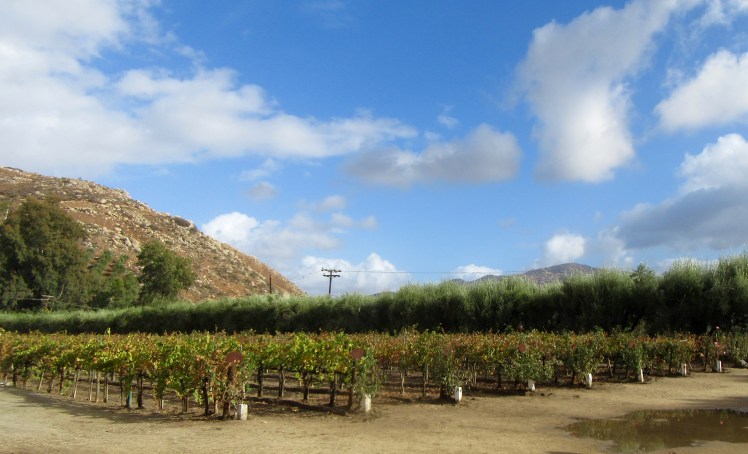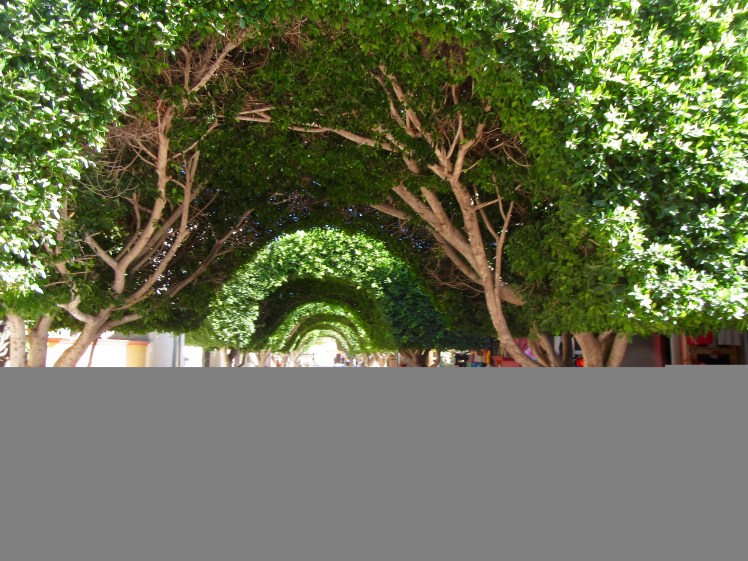With recent headlines about threats of violence against the busloads of migrants approaching Tijuana, along with border shut-down uncertainties, we headed to Mexico with a good measure of unease. We had made the decision long ago to avoid Tijuana (world’s busiest border crossing), and go through at Tecate, about two hours east. Now we figured this normally placid crossing might become swamped to avoid the mess at Tijuana, so when we arrived to find just one car in front of us, we wondered if we were at the right place. The kind customs official politely asked to inspect our trailer and the back of our truck and after about five minutes, he waved us through. We’ve felt far greater scrutiny (and far less warmth and welcome) crossing into the U.S. We found out later that the Baja/United States border crossings are fluid; many people work and live in either Tijuana or San Diego and cross effortlessly back and forth.
And so…our adventure in Baja begins. We will be here for at least two months and have begun our travels in a most delightful way – touring Mexico’s wine country. The Valle de Guadalupe (or Ruta del Vino) stretches from south of Tecate to the coast at Ensenada, and is now on the tourist radar. Luckily for us, early December is not peak season and we had our campground to ourselves.

Our only experience with Mexican wine in the past was nasty – warmish red liquid that burned the throat and rivalled cheap tequila for a hangover. Grapes have been grown in northern Baja since the 16th century, but it is just in the past 15-20 years that the “industry” has exploded; attracting winemakers from all over the world. There are between 100 and 150 small wineries, with Tempranillo, Cabernet Sauvignon, Cabernet Franc, Nebbiolo, Merlot, Syrah, Zinfandel and Grenache being the predominant red varietals. Interestingly, each small area with its rolling hills and protected acreages has its own microclimate. One winery produces superb Cabernet grapes and has ample access to water. Just two kilometres away at another winery, those same grapes would struggle to produce the same high quality – that ground is better suited to Syrah.

Many of the wineries plant olives and grapes side by side, as is the case with the gigantic L.A. Cetto; one of Mexico’s oldest and largest wineries. We stopped by for a wine tasting, and found the wines to be unexceptional. The smaller wineries do not hold Cetto in high regard; one young man smiled tightly at our mention of Cetto and referred to them as “commercial.”

Stephen and I are barely wine-literate; just skip through the photos if you are looking for keen insight and/or reliable information. But as the saying goes, we know what we like.
Our three days here were spent in a happy haze of driving through glorious countryside, chatting with passionate and informative people, admiring fabulous architecture and gardens, sipping glasses of very good wine, and eating very good food. Naturally, where there is wine, there is food and this burgeoning scene has also produced some astounding eateries – everything from food trucks to a restaurant run by a Michelin-starred chef.
Our first food experience was at Cocina de Dona Esthela; endorsed by Anthony Bourdain and described by FoodieHub as being “The Tastiest Breakfast in the World.”
Dona Esthela’s story is a big part of the visit. She was cleaning houses and doing laundry and cooking for the local workers when her reputation as a great cook began to circulate. Today, she still serves food from her property, but her takeout window has turned into a large dining room. Cars begin rolling in at 8:00 am and by 10:00 am there is a non-stop lineup until she closes at 5:00 pm.
What did we do before the Internet? We would have walked by this unassuming little place without a second glance.

Dona Esthela, still making tortillas and with a big smile for everyone.

I could not resist the corn pancakes and fresh fruit. That little dish with white cubes is queso fresco – slightly salty cheese made fresh each day – heavenly.

We also ordered two house specialities. Machaca, which is dehydrated beef mixed with eggs, vegetables, chilies and garlic, and served with a warm basket of tortillas, wrapped in an embroidered doily.

Stephen ordered the Borrego au jus – we’ll pass on the photo because it is simply a brown bowl filled with brown meat and brown liquid, but, to borrow a teenage expression, OMG. Lamb, seasoned and slowly cooked in an underground pit – the meat is so tender, so full of intoxicating flavours that any lamb you have eaten in the past simply pales by comparison.
All of this is washed down with freshly squeezed orange juice and cafe de olla, dark coffee made with cinnamon. If this was not the very best breakfast we have ever had, it came close. We didn’t even think about food again until dinner.
We visited 11 wineries in three days, and after just one tasting of four wines at Cetto, we opted to choose a glass instead and sit and relax and enjoy the properties and the views. We didn’t sample wine at every winery, but in all cases, there was plenty to appreciate.
The architecture and design in Mexico is exquisite. Mexican craftspeople have such a sophisticated eye for detail and their work is impeccable.

Even the rustic design is striking – wire structures filled with decorative rock.

A side wall of one of the wineries – built to resemble a Spanish hacienda.

At first glance, this winery, Finca la Carrodilla, appeared quite nondescript…

…until we climbed the stairs to the rooftop tasting room. Stunning plantings of succulents and cactus, far-reaching views and communal seating have transformed this space.

Las Nubes (Spanish for clouds) was another favourite. Simple, clean, spare – we sipped on a full-bodied blend called Cumulus and watched three stylish young women trim the room for Christmas.
This young man spoke perfect English. We noticed that a lot – there appears to be a comfortable foot in both worlds for many young Mexicans in this region, both staff and visitors.

Adobe Guadalupe – another photogenic winery.

We had a fabulous lunch here – fresh shrimp stuffed into soft floury buns and served with a little salad. Add a glass of red wine, a sunny table, some canine companions and a beautiful view – there are worse ways to spend an afternoon.

The owners also run a boutique hotel and raise Azteca horses, the sturdy breed favoured by Mexican horsemen.

While this region is small and compact, most of the roads leading to the wineries are packed dirt, in varying degrees of repair. You will lead from this lovely paved road:

…to this. You don’t need a 4×4 to navigate, just patience and a keen eye to avoid potholes and rocks. This is an example of a typical winery road.

Vena Cava, billed as “the hippest winery in Mexico” is only reached after a bone-rattling, torturous 20-minute drive on a twisting, rutted, washboard road that had us questioning our sanity to even attempt it. Finally, we arrived to this sight:

The winery design is fashioned from discarded boats, and is unquestionably hip – they even have a DJ. We were the youngest ones there by at least 30 years, and whether we were just annoyed by the drive, or annoyed by the fact that we are not hip, we felt put off and did not stay long enough for a glass of wine.
Still – Vena Cava is doing all the right things to add to the scene and to catch the attention of travel writers. They feature prominently in “Best-ofs” and “Must-see” lists, and for that reason alone are worth a visit.

We were fascinated to learn about the Russians who began growing grapes in this area over 100 years ago. This winery, Bibayoff has a small museum attached.

A photo of the original Bibayoffs. This small area still has a number of Russian descendants.

We spoke to David Bibayoff, the grandson of the founder and a most charming man who speaks English and Spanish fluently, but “very little Russian.” He talked to us about the area and how it has attracted so many interesting people from all over the world to move there, including a Canadian couple who were drawn to the beauty of the valley.
David and his son and grandson.

What would Mexico be without Frida? Casa Frida’s homage to the artist begins with the bright blue wall at the entrance to the design of the wine labels:

To the tasting room:

To the outdoor kitchen:

To the seating around the bar and pond. We ordered two glasses of Syrah and sat down to people-watch and enjoy the late afternoon sun. This was the last winery on our tour, and a memorable one.

Touring wine regions can almost be too much of a good thing. The wineries are only open for a few hours each day, and covering a lot of ground is a slow process. We may pop by again on our way out of Mexico.

Gorgeous! Have never been to Mexico but these pictures would encourage me to go.
Really enjoy your posts and pass them on to Terry to read as well.
LikeLike
Joan – we need to talk! There are so many places in Mexico that would fill your heart – all different, all wonderful – just like the people.
LikeLike
Really enjoyed this little travel log. Love the architecture of the wineries. Safe travels, you two.
LikeLike
Thanks Bridget – the architecture just grabs me too. I should start a separate photo album of just home and garden shots – so many inspiring ideas for when we settle again.
LikeLike
Not a box ‘o wine in sight!
LikeLike
Not a chance! Wine prices are not inexpensive, by Mexican standards for alcohol. A lower-priced bottle might run about $15, and they go way up from there. Tastings ranged from about $7 for 4 young wines to $35 for premium brands (4 1-oz. pours). I’m sure they aren’t matching Napa prices yet, but they’re getting there. There are more hotels and wineries popping up everywhere – we’d love to see how this place changes in five years.
LikeLike
We learn something new each time we read your blog … when I think of wine, Mexico doesn’t come to mind … until now, that is. Some of the wineries shown are in lovely settings – what a idyllic way to while away an afternoon!
LikeLike
Heather, we don’t normally drink in the middle of the day (no judgement!), but boy, I could get used to sitting in the sun with a decent glass of wine, overlooking the vineyards.
LikeLike